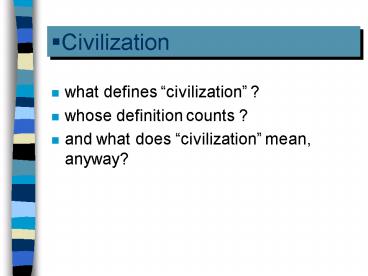Civilization - PowerPoint PPT Presentation
1 / 27
Title:
Civilization
Description:
centrally located: Tigris-Euphrates River valley. oldest ... Tigris and Euphrates. Contemporary Iraq, and a bit of Iran ... the expansion of trade and commerce ... – PowerPoint PPT presentation
Number of Views:345
Avg rating:3.0/5.0
Title: Civilization
1
Civilization
- what defines civilization ?
- whose definition counts ?
- and what does civilization mean, anyway?
2
Whose Definition?
- 18th Century European
- primitive vs. civilized
- white vs. everyone else
- beginnings of the concept of race
- race does not exist
3
General characteristics
- urbanization people living in cities
- surplus agriculture more than you can eat now
- metal technology not rocks
- writing words in a row
4
A modern definition
- Urban cities
- Surplus agriculture stored food
- Political/military systemgovernments and armies
- Social stratification differences in status
- Economic specializationl different jobs
- Religion religious figures parasitic on the
community, because they do god(s) work - Communications oral or written records
- Higher Culture art, literature, etc.
5
Earliest Civilizations
- in the Near (Middle) East
- three primary centers of origin and diffusion
- Mesopotamia, Egypt, India
6
Origins and Spread of Agriculture
7
Primary Phase Civilizations
- ca. 3000-2500 B.C. to about 1800-1500 B.C.
- either disappeared or changed by 1500 B.C.
- enjoyed contact with one another
8
Mesopotamia
- centrally located Tigris-Euphrates River valley
- oldest
- chief beneficiary of interaction between the three
9
Mesopotamia The Land between the Rivers
- Between the Rivers
- Tigris and Euphrates
- Contemporary Iraq, and a bit of Iran
- Cultural continuum of fertile crescent
10
Other Centers
- Egypt around the Nile River
- Indus civilization around the Indus River
- China
11
Common Characteristics ??
- water
- water
- water
- water
- water
12
Other Characteristics
- opportunity to adapt the environment
- suitable for domesticated plants and animals
- relatively stable (a bit hot) climate
13
Other Characteristics, cont.
- adjustments in the environment create surplus
grain - surplus food allows the expansion of trade and
commerce - deserts of the riverine cultures are short on
resources
14
Primary Phase Cultures
- have common characteristics
- these define a primary phase culture
- they are consistent, worldwide
15
No. 1 Agriculture
- cereal crops, especially barley
- bread and beer
- herd animals cattle, sheep, goats
- meat, milk, cheese
- leather and natural wool for clothing
16
No. 2 Planned economies
- require organized, mass labor (corvee)
- contruction and repair of canals and irrigation
ditches - community labor, by central authority
- control of production and storage of grain
- dispersion of foodstuffs among the population
- Redistributive economy
17
No. 3 Theocracies
- mobilized and directed by a ruling class of
priests, who control the society by blessings
and by threats - Sound familiar?
- the god(s) talks to us...not you! If you dont
do what we tell you to do, and if you dont give
us all your stuff, horrible things will happen to
you!! - theocracy a god-ruled state
18
Theocracies, cont
- priests function as an organized central
government, parasitic on the people - as earthly representatives of the god
- any modern examples?
- the king is regarded as a god or as a gods agent
- an earthly representative of the god
- any modern examples?
19
Theocracies, cont
- palace and temple (Church and State) are
combined - power is derived from an unchallengable, higher
reality...unquestionable authority - If you question it, you are evil
- the gods will must be done for the community to
survive - priestly class holds unlimited power
20
No. 4 Social Classes
- priestly class is part of the beginning of social
differentitation - that is, class stucture
- class structure based on specialization of labor
- generated class differences
21
Class structure
- priests (We talk to god, you dont.)
- aristocrats/warriors (We have weapons, you
dont.) - common people (I guess we work...?)
- slaves (Were screwed!!!)
22
No. 5 Industury
- pottery, textiles, beer (!), woodworking, and so
forth - production of luxuries (Things You Dont Really
Need) - development and improvement of metal technology
- at this stage BRONZE
23
No. 6 Architecture
- monumental architecture
- pyramids, ziggurats, big cities
- hugh temples and associated structures
- to fill the needs of a god-oriented state
- under the control of the priestly class
24
No. 7 Writing
- perhaps the most important invention EVER
- record keeping, literature
- land tenure
- religious documents
- political and religious propaganda
- any examples you are familiar with ???
25
No. 8 Organization of Knowledge
- learning becomes cumulative, not
start-from-scratch - perpetuates the level of achivement
- scribes and schools
- medicine, astronomy, calendars, mathematics,
divination
26
The Information Age
- This is the beginning of the Information Age
- Whoever controls the information can make whoever
produces and controls you - worship like they want, tell you which gods are
real and which arent, and make you suffer or die
if you object - work like they want, and tell you what system is
best, and then make you pay them your money and
thank them for the privilege - And make you go where they want, kill who they
want for the stuff those people have, and tell
you Its all for you! I am nothing but your
servant!! And Gods servant, too, of course!! - They decide what are traditional family values,
values which support them and keep them in power. - Sound familiar?
27
Books to read
- Robert J. Wenke. Patterns in Prehistory
Humankinds First Three Million Years - Charles Keith Maisels. The Emergence of
Civilization From Hunting and Gathering to
Agriculture, Cities, and the State in the Near
East - The Cambridge Ancient History Prolegomena and
Prehistory































